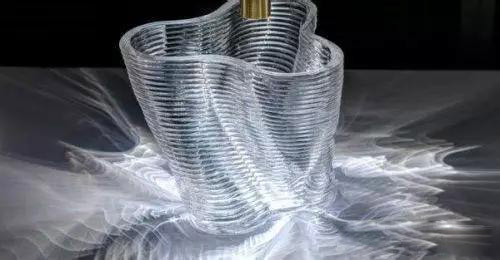

Scientists and academic collaborators at Lawrence Livermore National Laboratory ( LLNL ) in California have demonstrated the synthesis of clear glass through 3D printing. This development may eventually lead to changes in the design and construction of lasers and other devices that include optical components. This synthesis process is described in detail in a paper published in Advanced Materials.
Other research institutes have shown that 3D printing of glass is possible, however previous demonstrations involved extruding molten glass filaments by heating the printing head or using a laser to selectively melt and melt the glass powder. LLNL 's approach does not rely on printing molten glass, but rather on the development of custom inks formed from concentrated suspensions of glass particles that are highly controllable and therefore printable at room temperature. The printed components are then subjected to a reasonably designed heat treatment to densify and eliminate traces of the printing process. Finally, the processed components are optically polished. The researchers say the method increases the likelihood of optical uniformity in optical components.
Mr. Du Yuyi, LLNL Materials Engineer, said: “In order to print high quality optical components, no pores or lines should be seen. They must be transparent.” They tested a large number of material mixtures before finding the right material components. . “When we get a common formula, we can adjust it so that the material can blend in the printing process. Most other methods of printing glass are to first melt the glass and then cool it down, which may cause residual stress to cause cracking, and We print at room temperature and there is no such problem."
The LLNL method uses a slurry that extrudes silica particles by a direct ink writing process. The printed product is opaque but becomes transparent after drying and heat treatment. The researchers say that unlike 3D printing using molten glass , this method does not require high temperatures during printing, allowing for higher resolutions.
Nguyen said: “Polishing complex or aspherical lenses is quite labor intensive and requires a lot of skills, but polishing the plane is easier. By controlling the refractive index of the printed components, the curvature of the light can be changed, making it possible to polish The mirror is flattened."
Researchers say they are not replacing traditional optics, but rather exploring new applications of chemical composition gradients that are not currently available on the market. The design of novel optical components to replace off-the-shelf optical components can reduce the size, weight or cost of the optical system.
Researchers say the research can expand the design space of optical engineers and may also be used outside of optics, including glass microfluidic devices that are complex and previously unavailable. Glass is a precious material for microfluidics due to its optical transparency, chemical resistance, mechanical properties, and the ability to adjust its surface chemistry and functionality. However, glass is difficult to process and etch to achieve a microfluidic device with complex geometries. Glass 3D printing may change this situation, and the research team also demonstrated 3D printing of a simple microfluidic network .
Now the research team has proven that it is possible to print transparent glass, and researchers are making high-quality optical and graded-index lenses by changing the composition of the glass. The next obstacle to overcome is the graded index ( GRIN ) optics, which will require more familiarity and control of the process.
 The US developed a 3D printed transparent glass at room temp…
The US developed a 3D printed transparent glass at room temp… Guangdong Provincial Association of Industry Associations 20…
Guangdong Provincial Association of Industry Associations 20… Taifeng City Duanfen Meijia Courtyard Tour
Taifeng City Duanfen Meijia Courtyard Tour The high price of energy-saving glass is the threshold for t…
The high price of energy-saving glass is the threshold for t… What are the development opportunities for the glass industr…
What are the development opportunities for the glass industr… Research and development of building glass film to achieve e…
Research and development of building glass film to achieve e… Tour of Douyama Town, Doosan Town, Taishan City
Tour of Douyama Town, Doosan Town, Taishan City Chinese decorative art glass market is good
Chinese decorative art glass market is good